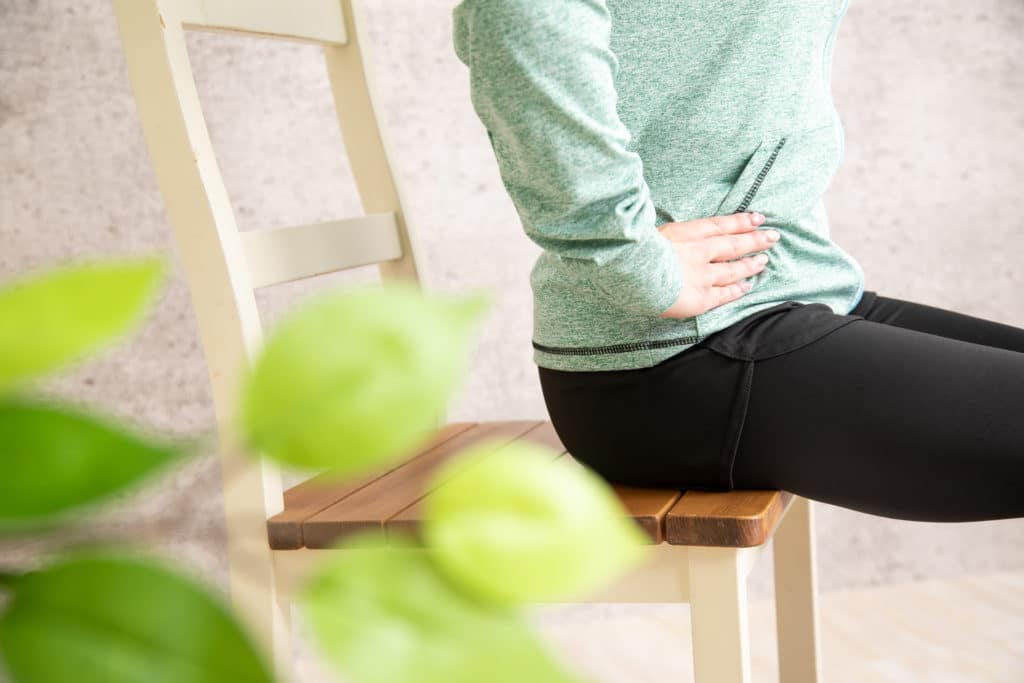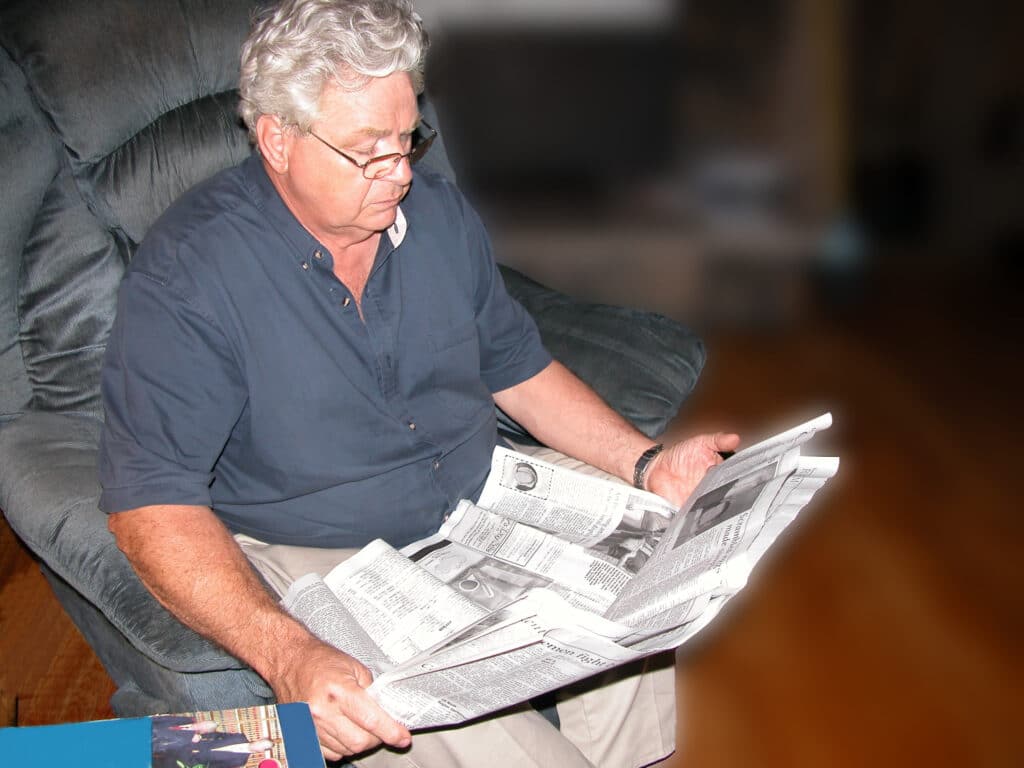Sitting with back pain can be very uncomfortable for many older adults. Whether it is sitting in the car, on the couch or on the floor, different scenarios call for different approaches for back pain relief. While sitting and back pain are not always related, there are some rules that you can start following today to get your discomfort under control.
By working on posture, paying attention to your position, and keeping moving throughout your day, you can limit back pain from sitting to improve your quality of life.
This article explores the causes of back pain, some simple guidelines, and common scenarios where you can adjust your daily life for more comfort.
The Causes of Sitting Pain and Discomfort

Back pain can be influenced by many factors unique to your lifestyle. However, some common causes of sitting discomfort for older adults include excessive pressure on the spine, muscle tension, and circulation issues.
Spinal Pressure
Prolonged pressure without regular position changes can lead to stiffness and inflammation in your back, which causes common problems such as back pain when driving.
Your spine is under constant pressure throughout the day from gravity, especially your lower back. When you sit in any position for an extended period, the strain on your lower back will be focused on some areas more than others. This effect can be even more pronounced when leaning over for extended periods.
Posture-Related Muscle Tension
The muscles around your spine are like masts on a ship that help hold everything in place. Each muscle serves a purpose to keep your spine correctly balanced.
They pull on your spine unevenly when they become fatigued or imbalanced from sitting in certain positions for long periods. This muscle imbalance can lead to painful muscle tension, making it harder for your lower back to function properly.
Circulation Issues
Circulation is a process of both sending essential nutrients to the tissues and removing waste.
When normal circulation is slowed or stopped, problems can arise. Sitting in certain positions, or for long periods, can have a negative impact on circulation to your lower back and hips.
This can lead to familiar problems like numbness, tingling, and dull pain. In some cases, you may even notice leg symptoms such as legs “falling asleep” because of reduced circulation to the nerves of your leg.
The Role of Your Chairs

One of the most significant factors in developing problems with spinal pressure, muscle tension, and circulation is the fit of your office chair.
When your back, arms, or legs aren’t supported properly, it can cause additional stress on your spine. In my experience, some patients only need minor changes in their car seat or desk setup to significantly improve their lower back pain over a very short period (more on this later).
It’s important to know that many older adults live with preexisting conditions which can affect pressure, muscle tension, and circulation in their lower back. Discussing your health history with your doctor or physical therapist can be crucial in identifying the most critical influences on your lower back pain when sitting.
Universal Sitting Rules
For many older adults, sitting is an unavoidable part of everyday life. This means finding the most effective strategies for limiting pain and discomfort while sitting is vital. Here are five rules that you can follow to find the best sitting position for lower back pain:
Posture Matters
When we sit for long periods, posture can significantly affect our overall comfort. Slouching or arching your back can put extra stress and tension on one side of your spine or the other.
An easy-to-remember rule when sitting is to keep your back neutral without arching, slouching, or leaning to one side.
Find Support
Keeping your lower back neutral can be challenging, and some chairs can make it difficult to hold a good position.
Modern desk and car seats often offer adjustable lumbar support to modify your sitting position. If your chair provides lower back support, ensure you use it to help your back get into a neutral position.
If your chair doesn’t have support, you can use cushions or a small lumbar support pillow, sometimes called a sitting wedge, that can be used at home, work, or in the car to redistribute pressure.
Don’t Forget Your Core
Remember all those muscles that help support your spine? It’s essential to know how to use them while you’re sitting.
If you’re entirely relaxed while sitting, your back will follow the path of least resistance and often end up in a less-than-ideal position.
By gently engaging your core muscles while sitting and focusing on posture, you can help even out the stress on your lower back more quickly.
Move Often
Focusing on posture is essential, but modern research shows that breaking up sitting time with movement is the most effective way to reduce back pain and discomfort.
Even if you sit with “perfect posture,” you’ll still want to plan for activity breaks and position changes throughout your day. Moving often helps with joint and muscle health, so focus on getting up and moving when possible. The best posture is your next posture!
Get The Right Fit
How you set up your chair can greatly impact your back pain. You can help ensure the best positioning possible while sitting by measuring specific distances and angles.
This is especially relevant with office chairs with adjustable components but is still important to monitor with any chair you regularly use. For example, ensuring your thighs are slightly beyond the edge of your seat can help reduce pressure on your lower back.
Many of my patients understand a few of these universal rules, but few utilize all of them. In my experience, adding one or two practices into a patient’s sitting routine can effectively “fill in the gaps” and create less pain during sitting without overwhelming you with new things to remember.
Now that you better understand how to find the best sitting position for lower back pain, let’s cover a few basic situations you’ll encounter regularly and how to adjust them to avoid pain.
Common Sitting Scenarios

Although your daily routine will be unique to your lifestyle, there are some common sitting scenarios that many older adults will encounter during their day.
Let’s discuss the five most common situations and essential considerations to limit back pain from sitting.
The Car
Sitting in the car can be unforgiving, and many older adults struggle with back pain when driving.
When adjusting your seat, set it so it fully supports your back. You should not need to lean forward to use the steering wheel. It’s also wise to bring your seat forward enough to stop your lower back from arching while using the pedals. Use a small pillow or sitting wedge for added lumbar support if possible.
The Couch
While the couch may seem comfortable at first, it can lead to back pain and discomfort for many older adults over time. When choosing the best couch for back pain, aim for one that supports your thighs and most of your back while allowing your feet to touch the floor.
Additionally, ensure that the couch is soft enough for comfort but not so soft that your back slouches into the cushion. It can also be helpful to try a foot support or ottoman for minor changes to the overall support of the couch you are currently using.
And remember: frequently changing your position is helpful. If you find yourself in the same position every time you sit on your couch, try changing it up occasionally.
Home and Office Chairs
Many older adults spend most of their day in an office chair with adjustable features. When setting up your office chair, make sure that the chair fully supports your back.
Your legs should be parallel to the floor, and the backs of your lower legs about one fist in front of the edge of your seat.
If your chair has an adjustable back, angle it slightly forward to give support when sitting upright instead of leaning back. While some chairs have adjustable lumbar support, you may need to add a towel roll or pillow to prevent slouching.
Picking the right chair is essential if sitting in a standard chair without adjustable features.
Start by checking that the chair is the right height for your heels to touch the ground. Next, ensure that the back of the chair is close enough to support your lower back while still allowing some distance between the backs of your knees and the edge of your seat.
Since standard chairs are less comfortable for long bouts of sitting, you may add various pads and pillows to get your setup right for your needs.
Suppose you are sitting on a bench with no back support. In that case, having your feet firmly on the ground and your hips entirely supported by the bench is especially important.
In this scenario, focusing on your posture by gently lifting your chest and activating your core muscles can help you maintain a comfortable position. Many older adults have trouble sitting on unsupported benches for long, so take frequent activity breaks when you can.
The Floor

Sitting on the floor isn’t a popular option, but this situation might come up from time to time. If you struggle with sitting on the floor, it’s essential to have a strategy for comfort and safety.
Sit with your back against a wall to help prevent excessive slouching and to bolster your endurance. To improve safety, position yourself near a counter or other sturdy furniture to help stand back up when needed.
If neither a wall nor furniture is available, but you are confident in your ability to stand back up, focus on changing positions often and use your hands periodically to take some stress off your spine.
Adjusting your sitting technique may feel awkward or uncomfortable initially, so start by making small changes and slowly increasing the time you use any new approach.
Key Takeaways
- Many older adults face back discomfort from prolonged sitting.
- Spinal pressure, muscle tension, and circulation issues are common causes of sitting pain.
- Proper chair fit, support, and posture are vital in alleviating back pain.
- Regular movement, position changes, and active core engagement are essential for back health.
- Adjustments in car seating, couch choice, office chairs, and bench use can enhance comfort.
- Consultation with a medical professional can address individual concerns and preexisting conditions.
- Gradual modifications to sitting habits can lead to lasting comfort and improvement.
FAQs
Is it normal for older adults to experience back pain just from sitting?
While many older adults experience back pain from prolonged sitting, it’s not necessarily a “normal” part of aging. The pain is often a result of posture, pressure, or circulation issues that can be addressed with adjustments and proactive strategies.
I’ve just started focusing on my posture. How long will it take before I see improvements in my back pain?
Everyone is different, but many individuals notice improvements within a few weeks. Being consistent and patient is essential as your body adapts to these changes.
Is there a specific type of cushion or lumbar support pillow that is best for back pain?
The best cushion or lumbar support is the one that helps you maintain a neutral spine and reduces pressure on your lower back. Finding the best fit for your body and chair might require some experimentation.
How often should I take breaks from sitting throughout the day?
Ideally, it would be best if you aimed to move or adjust your position at least every 30 minutes. Even short breaks or simple stretches can significantly affect how you feel.
I’m considering getting a standing desk. Can that help alleviate back pain?
Standing desks can relieve the pressures of prolonged sitting, but it’s essential to ensure you’re standing correctly with good posture. Alternating between sitting and standing throughout the day can be beneficial.
Is there a particular material or type of couch that is better for individuals with back pain?
Firmer couches that offer good support yet enough cushioning for comfort are generally better for those with back pain. Avoid couches that cause you to sink in too much, leading to slouching.
How can I best adjust my car’s seat for long drives to prevent back pain?
Ensure that your seat is adjusted so you can easily reach the pedals without overextending or arching your back. The back of the seat should support your entire spine, and a lumbar support or cushion might be beneficial for longer drives.
I have a history of specific back injuries. Should my approach to sitting be different?
It’s essential to consult with a healthcare professional or physical therapist about your specific back issues. They can provide guidance tailored to your individual needs and history.
References
- Jung KS, Jung JH, In TS, Cho HY. Effects of Prolonged Sitting with Slumped Posture on Trunk Muscular Fatigue in Adolescents with and without Chronic Lower Back Pain. Medicina (Kaunas). 2020;57(1):3. Published 2020 Dec 23. doi:10.3390/medicina57010003 https://www.ncbi.nlm.nih.gov/pmc/articles/PMC7822118/
- Go EJ, Lee SH. Effects on sitting pressure distribution during the application of different cushions and anterior height wedges. J Phys Ther Sci. 2017;29(3):390-393. doi:10.1589/jpts.29.390 https://www.ncbi.nlm.nih.gov/pmc/articles/PMC5360996/
- Ergonomics for Prolonged Sitting. UCLA Health. https://www.uclahealth.org/medical-services/spine/patient-resources/ergonomics-prolonged-sitting





